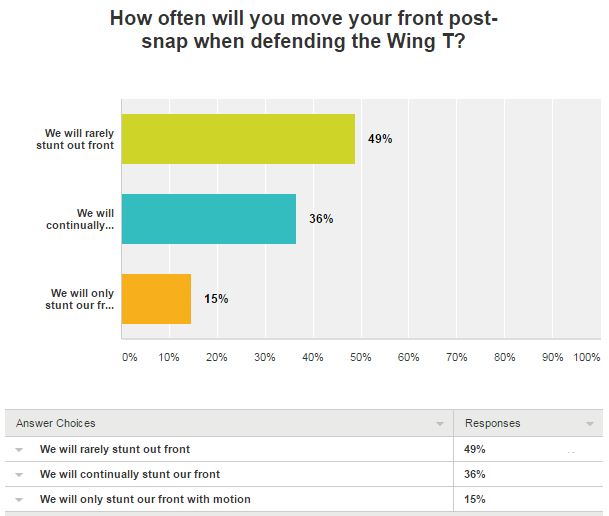By Mike Kuchar
Senior Research Manager
X&O Labs
Twitter: @MikeKKuchar
Introduction
The following research was conducted as part of X&O Labs’ special report on “Defending Unconventional Offenses.” Insiders members can access the full-length special report, login here.
Movements to Defend Wing T Run Concepts:
There seems to be conflicting opinions on whether or not to move the defensive front post-snap when defending the Wing T. According to our research, 49 percent of coaches choose not to move their front post-snap when defending the Wing T run game. While 35 percent will continually move their front and 16 percent will only stunt with motion.

Movements in Four Down Fronts:
Sparta High School, a perennial public school powerhouse in New Jersey has had success defending Wing T run game from its 4-2-5 front by mixing in several post-snap run movements by its first level defenders. On almost every play, Defensive Coordinator Christopher Kappelmeier will make sure one or more of his defensive linemen will be stunting into the adjacent gap or across the face of the offensive man and he’ll teach the proper stunt technique early in the preseason and practiced regularly. Many of them are gap exchanges which include second level linebackers as well.
“The linebackers need to know which gaps the defensive linemen are stunting into at all times because they will need to fit those gaps that are opened by stunting linemen should the flow head in that direction,” said Kappelmeier. “By moving our defensive linemen and linebackers on most plays, we make it very difficult for offensive linemen to execute their blocking schemes, particularly man or gap blocking schemes like the Wing-T.
“At Sparta when we practice our gap exchanges we do it during the inside run period. It is vital that the stunting linemen and linebackers be able to read and react while moving. Defensive linemen learn by repetition to read the offensive linemen toward whom they are stunting. Linebackers learn by repetition how to fit open gaps and not get caught between stunting defensive linemen. We have found that the movement of the defensive front, even if it doesn’t seem to be fundamentally sound on paper, very often creates situations in which defenders are totally unblocked and in position to make big plays. Pre-snap we try to look the same every play. The only player who may need to change his alignment is the nose. If he is stunting into the B gap, he aligns in a 2i-technique. This does not telegraph his intention to stunt because that is his alignment in the tight G front which is used often.”









